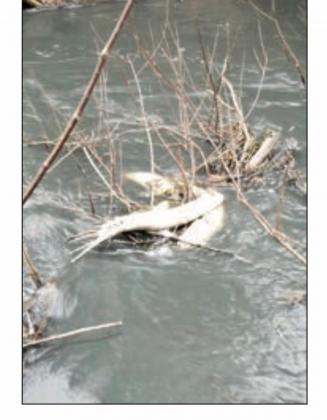DSHS: No money for testing
A photo of dead fish in Skull Creek taken on the day of the Feb. 8 contamination incident.
Editor's Note: Following the publication of this story, DSHS told The Citizen they were now working with TCEQ to obtain their water samples for testing. Full story in the May 8 edition.
ALTAIR—A spokesperson for the Texas Department of State Health Services, the state agency responsible for issuing fishing advisories and bans on Texas waterways, told The Citizen Monday the agency did not have money for water and other testing necessary to determine if contamination in the Colorado River at its confluence with Skull Creek was sufficient to issue a ban or advisory.
Water from Skull Creek containing an odorous, dark, black pollutant determined by state environmental regulators to contain ethylbenzene and more than half a dozen other chemicals toxic to fish in amounts that render fish in Skull Creek “unsafe for human consumption,” reached the Colorado River about two weeks ago, and continues to flow out of the creek in to the river.
Area sports fishermen participating in a weekend catfish tournament along the span of the Colorado River within the county contacted the newspaper Monday with photographs of a large, dark, black cloud of contaminant in the river near its confluence with Skull Creek asking why the state had issued no fishing advisories or bans.
Colorado County last week erected signs along County Road 16 at the low water crossing of Skull Creek warning people that the water in the creek was toxic.
County government, however, has no legal authority to issue a fishing advisory on the Colorado River. Neither does the Lower Colorado River Authority, an agency spokesperson confirmed Monday.
Although many believe the Texas Parks & Wildlife Department is responsible for issuing fishing advisories or bans, that duty actually falls to another state agency—the Texas Department of State Health Services, a division of Texas Health & Human Services.
Chris Van Dolen, a spokesperson for DSHS told the newspaper Monday by phone that extensive testing of water and marine life is required in order to issue a fishing advisory or ban.
“We’ve not been asked to do testing,” Van Dolen said.
“We really don’t have the funds to do it on our own,” Van Dolen said.
Instead, Van Dolen urged sportsmen to simply use common sense, saying that if the water is black or smells funny, “it is a good idea not to eat the fish from that area.”
According to the agency’s Fiscal Year 2018 Budget, the most recent budget easily found on its website, the agency projected nearly a billion dollars in expenditures—$838,699,969.
Its laboratory services budget is listed at $20,574,355, with $15,507,350 reserved for salary and wage expenses, and $15.95 million budgeted for “other operating expenses.
The agency’s website lists a line item of in excess of $24 million for licensing and regulatory compliance relating to “food (meat) and drug safety.” It is unclear if that covers fish. The agency’s regulatory website separates seafood regulation from other food-related regulatory activities performed by the agency.
The agency’s budget claims it performed 1,578,890 lab tests in 2017.
According to a posting on DSHS’ website, the agency’s job “is to promote and protect the health of people, and the communities where they live, learn, work, worship, and play.”

